Vol. 1, Iss. 10: Seven Minutes Or Less
PHX only got 7 minutes out of this lineup all season. But as we watch the NBA Playoffs unfold, how could you not wonder about it's potency for next season?
Before We Get Stuck In:
If you decided to donate after the last issue, thank you. If you are reading for the first time and like what you see, please hit the subscribe button below. And if you are normally a subscriber but have come here direct from Twitter etc this time, be sure to check the newsletter isn’t ending up in your junk or promotions folder.
Move over 7 Seconds Or Less…..
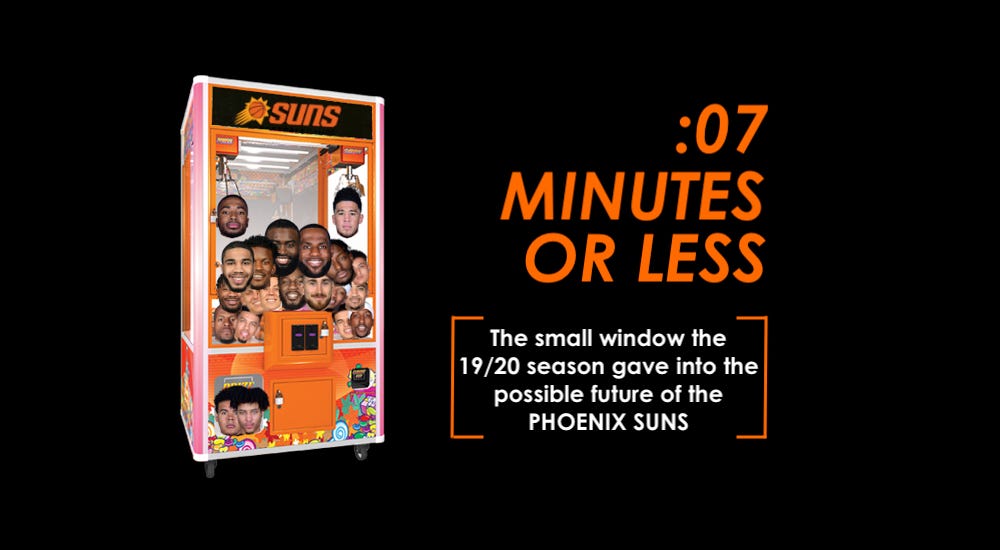
What do - Andre Iguodala, Danny Green, Duncan Robinson, Gordon Hayward, Jae Crowder, Jaylen Brown, Jayson Tatum, Jerami Grant, Jimmy Butler, Kentavious Caldwell-Pope, Kyle Kuzma, Torrey Craig and Tyler Herro - all have in common?
If you take the top eight rotation players from the four Conference Finals teams - Celtics, Heat, Lakers & Nuggets - you will find 13 guys between 6’5 and 6’8 that fit the typical Wing archetype. That’s a tick over 40% from the total pool of 32.
Although Alex Caruso (6’5), Markieff Morris (6‘8) and Paul Millsap (6’7) all fit the athletic mould, they fill different roles functionally on the hardwood. Thus, were disqualified from the pool.
While the opposite could be said for Gary Harris (6’4 with a 6’7 wingspan), LeBron James (6’9), Marcus Smart (6’3 with a 6’9 wingspan) and Michael Porter Jnr (6’10). They may not fit the typical measurement criteria, but they act as Wings on the court. Throw them in.
All of a sudden, more than half the rotation players from the top 4 teams are Wings. Not to mention Derrick Jones Jnr & Grant Williams, who fell outside the Top 8 rotation minutes for their respective teams at the time of writing but may yet have a key role to play in the Playoffs.
So how does all of this relate to our Phoenix Suns?
Well……Boston, Miami and Los Angeles, each have one of these Wings as part of their superstar duo leading them to the promised land in the Bubble. With other complimentary 3&D types in the supporting cast. And for Denver’s duo of Jokic and Murray, they are instead surrounded by as many other Wings as they can get on the floor at once.
For the Suns, they currently have one star - Devin Booker - and three key rotations pieces that fit within that 6’5 to 6’8 Wing span; Cameron Johnson, Kelly Oubre Jnr and Mikal Bridges. Not only that, they have Deandre Ayton sitting in the middle. And as we covered in Issue 9, he likes to cosplay as a Wing in more ways than one. For better or worse.
How long have this quintuplet shared the court in the purple and orange? 7 minutes.
If you’ve been watching the NBA Playoffs like I have, I am sure you have noticed the flood of switchy athletes on the court and the benefits it can bring. Never too far away from a hopeful Suns thought, I am sure you have also wondered what the future might hold for Phoenix if they join the NBA’s elite in the Playoffs any time soon.
I dug up every second the Ayton-Booker-Bridges-Johnson-Oubre lineup played this season and invite you to join me on our own daydream of what might be for 20/21.
Note: if you are currently reading this in your email, the content from here on is likely better digested on the site - here.
It Starts With Stops
Despite only deploying the All-Wing lineup against four teams in the regular season, Monty Williams did pull the lever when the Suns found themselves in some interesting scenarios. We saw The Phoenician Five (Yes I’m calling them TPF until a better idea comes along - sue me) against Atlanta, Denver, New York & Portland. And almost exclusively down the stretch of close games, where defense was needed. Interesting.
It would appear Coach Monty and the rest of the Suns staff, see the value in throwing all that length out there to generate stops and I’d agree. The allure of this lineup really starts with what they can do on that end of the court. Let’s take a look…..
The Switch Blade Suns
Our first peek at TPF in action comes against the Knicks and everything worth seeing happens before the ball is even live. It can’t be ignored that the Suns are up a full two possessions here and therefore know the deep ball is the main threat. However, how the guys in orange navigate and communicate through all the movement is quite impressive.
Count out the switches….
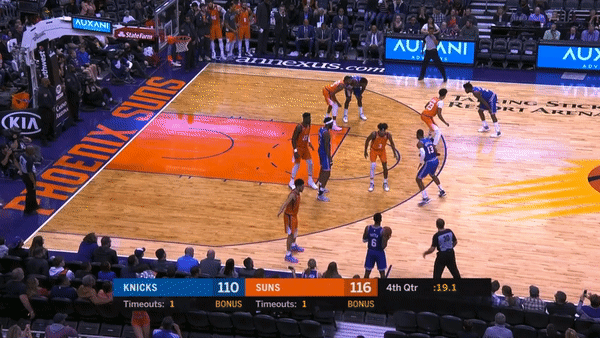
Next up, the Suns went with the Wing heavy lineup while trying to claw back the Blazers in December. Without a traditional point of attack defender like Ricky Rubio, it becomes much harder for the opponent to hunt mismatches. Ayton, Booker and Johnson are all on their logical counterparts, with Oubre taking Lillard and Bridges on Anthony. The Blazers go to Melo in the post and try twice to force a switch.
Problem being, they switched off 6’6 with a 7’1 wingspan Bridges and onto 6’7 with a 7’2 wingspan Oubre.
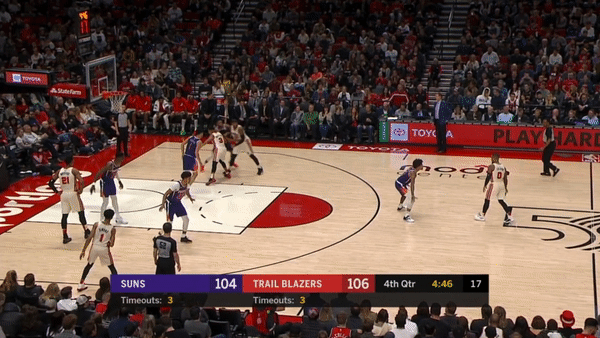
In February, the Suns competed hard against the current Conference Finalist Nuggets. We are used to seeing our team run a lot of handoffs to confuse defenders and find the seams to attack in the defense. Bridges and Ayton execute a very quick double switch here, to stifle Gary Harris’ drive and force the ball out of his hands.
The stunt and recover from Oubre is something we are seeing a lot in the Playoffs at the moment, with great effect.

Helping The Helpers
“Help The Helper” might not be a term a lot of Suns fans are used to hearing. Our franchise in the Valley doesn’t exactly have a defense first reputation. Better yet, being just functional on that end has been a long time coming. But it is a term that good Playoff teams have down to a fine art. Watch as Phoenix fly around the court, finding the open man when a teammate rotates or switches to cover theirs.
Ignore the last second mistake from Booker here and Whiteside hitting a shot you are typically okay with him taking, and you’d be forgiven for getting just a little bit excited by all the disruption.
I’d file this somewhere in between elite defense and complete chaos.

This clip shows the real beauty in playing Bridges, Johnson and Oubre together. Oubre fronts Millsap in the post and forces Denver to give up on that option. Bridges starts out guarding the initiator and although the Nuggets try get him switched off, he cleverly never takes his eyes off the ball. As for Cam, this play highlights why his team defense abilities will make up for a lot of his individual deficiencies. He rotates onto Mikal’s man, before closing out hard with length on the shot.
Now if they could just secure the rebound. A great example of when Ayton needs to realise he’s in no man’s land and get to the hoop, instead of ball watching.

The Key To It All
Believe it or not, Ayton will be the key to how dangerous TPF can be on the defensive end. Just as Booker will need to ensure he can’t be targeted too, the entire idea will fall down in key moments if Ayton isn’t able to hold up his end of the bargain. The good news? Just as we discussed in Issue 9, he has all the tools to strap his own costume on and fly with the Wings. Occasionally, he will even be lead instigator.
Watch as his forces the ball out of Young’s hands with the double, recovers in time to be the vertical deterrent and then stays solid in the post to create the turnover.

As I mentioned, if the Suns lean into this lineup more then teams will look to target Booker and Ayton to stay away from everyone else. That will result in Ayton finding himself on an island often, with the stadiums bright lights burning through the top of his scalp. There’s absolutely nowhere to hide when the NBA’s elite initiators want to try toy with you like their food. A truly thankless task when the best you can hope for is mild applause, should you prove up to the task and out of Sportscentre’s Top 10.
How many legit NBA big men can hang with a guy like Trae on the perimeter like this and make him give the ball up?
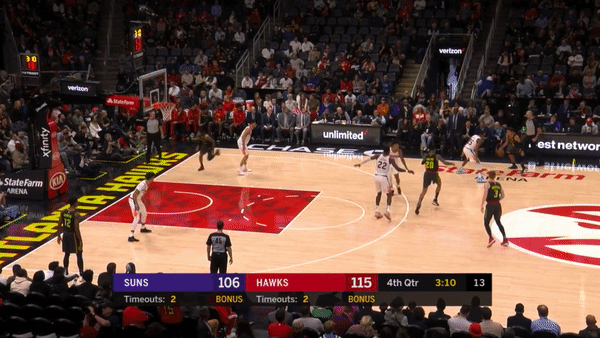
Optimizing Point Book
That’s enough defense for now, let’s switch (couldn’t resist the pun) to the other side of the court. It has to be said, that Phoenix only won half of the games where TPF was deployed this season. Given it was used VERY sparingly, that’s not exactly something to panic about. But for us to see it more in the future, it’s just as important that it can generate buckets down the stretch than it can stop them.
In the games the Suns lost, the lineup was used to try claw back the Hawks and Nuggets. It failed to do so. While it managed to hold off the Knicks and the Blazers. Based on the small sample size, but also just what we have come to know about the individual players, I do think #PointBook can find success offensively with this mix.
The league knows by now that Booker as a primary ballhandler is a dangerous sight. With a healthy dose of half court action centered around himself and Ayton, plus increased transition opportunities, TPF can become feared on both ends.
Half Court Hell
Booker (35.4%), Oubre (35.2%) and Johnson (39.0%) were the Suns top three most prolific three point shooters last season. While Bridges’ 4.7 attempts over his last 15 games, would have placed him fourth on that list. Which feels significant considering he also rose from 36.1% on the season to 41.4%, on that late season tear.
Phoenix can really maximise spacing, starting with two of the Wings sitting in the corners.
On this play, they then use Ayton as a high screener and Johnson as a movement threat. Booker is able to attack going down hill, with zero help defense because everyone is glued to their man.
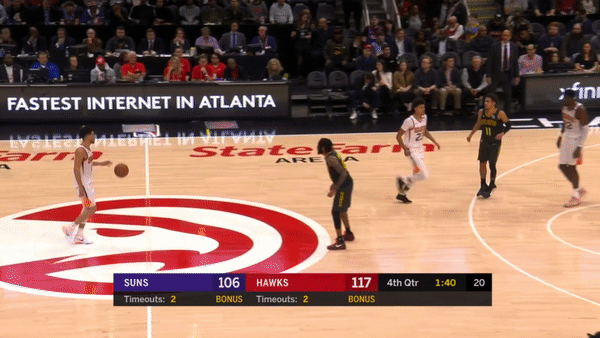
Again we see Bridges and Oubre in the corners, with Ayton’s roll gravity and Johnson’s shooting gravity used within the action. The Suns run high Pick & Roll and Denver chooses to double Book off the screen. As Ayton rolls down the lane and Johnson pops to the three point line, Booker is able to release to the open guy and create confusion among the Nuggets defenders.
Cam could of let it fly but instead makes the extra pass to Kelly, who in turn decides to get a little extra on the play himself.
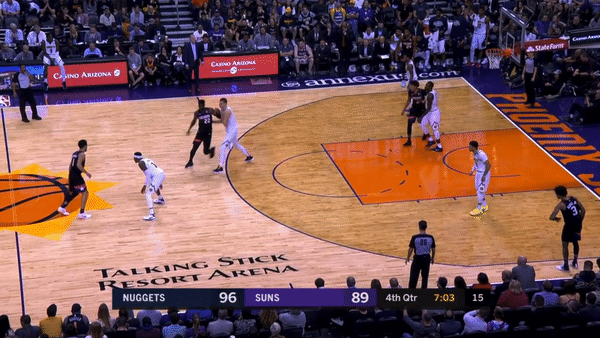
Back To The Future
Just like in the first section focused on defense, a lot of the success of TPF boils down to Ayton’s role in it all on offense too. I’ve recalled back to Issue 9 three times now, in referencing Ayton and no promises that it won’t happen again before we finish. But the importance can’t be overstated. It’s all about simplifying Ayton’s role, rather than expanding it. And having him contribute in a big way with the things he’s shown to be very capable of already.
This first clip isn’t one of them. I would advise strongly against using over half the shot clock to generate an elbow touch for Ayton with this group. Not only is it not playing to the lineups strengths, he might decide to dance his way into a turnover.

This is much more like it.
Ayton sets a high screen to get Booker free for a midrange J. He then chases down the offensive rebound and quickly releases to Book, back out on the perimeter. He sets another great screen on McCollum, which forces the help to come, and takes more help defenders with him as he rolls to the rim. Booker gets his head up and is presented with a plethora of shooters to choose from.
Don’t want to sound like a broken record, but it’s the little things with Ayton that will wind up making him great.
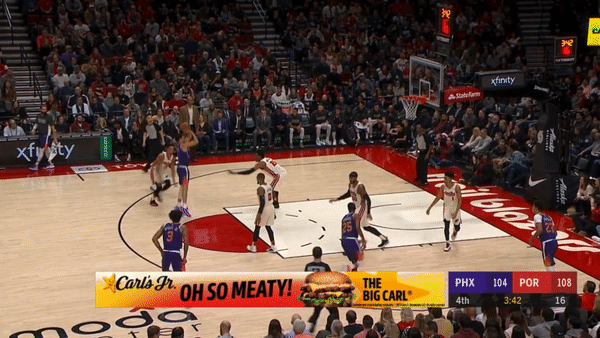
Another Ayton screen forces Denver to switch. With Millsap on him and Ayton in the paint against Harris, Booker backs it out to assess where the weak-spot is. Once he blows by Millsap with the quick first step, the lob to Deandre was always going to be a gimmie.
Super important that Cam relocates to the opposite corner when Booker retreated. Not only did he remove a potential help defender on Ayton, he’s the best shooter of the bunch and therefore couldn’t be helped off on the drive.

Lost In Transit
The 19/20 Phoenix Suns were the best transition team in the NBA. Scoring 1.20 points per possession on 56% shooting, one could argue they needed to find even more transition opportunities than the 16% they did last season.
How do they do that? Well occasionally replacing Rubio (25th %ile in transition) at the head of the snake, with Booker (66th %ile) might be a good start. Why? Because then there’s still four spots on the floor, for Ayton (95th %ile), Bridges (93rd %ile) and Johnson (88th %ile) to all get out in the open court.
Watch as the threat of Booker on the break, Ayton pressuring the rim and Oubre & Johnson running the lanes - gets Bridges a wide open three he’d normally make.

To finish, a little defense to offense. We see two more switches force the turnover and the Suns are off on the break. All five Hawks players touch the paint on the other end before the shot goes up, speaking to the pressure the Suns place off of the turnover.
The only Hawk to leave it then tries to contest Cam’s shot. Too late.

The Case To See It More
If all three non-Booker Wings are on the opening day roster for the Suns, there is bound to be a lot of discussion about who should start. And rightly so. But perhaps just as important, is the question of how much Monty can get them all on the court together next season.
Will we see The Phoenician Five more than seven minutes all season? I’d bet on it.
It was just 7 minutes, so not much can be said of the +39.6 net rating the 5-man lineup possessed this past season. Nor the +9.4 Bridges/Johnson/Oubre plus Ayton had in 24 minutes, or the +6.1 for Bridges/Johnson/Oubre plus Booker in 19.
But when you see the Bridges/Johnson/Oubre trio sported a healthy +6.3 rating in 161 minutes together, you start to wonder how you could go wrong combining them with the Ayton/Booker duo that went +7.4 in 983 minutes this season.
I’m on the record already as saying the Suns need another play-making guard and that long term, Oubre might not be the greatest fit with the current core. But whilst I’d support a trade that brings in what I’d consider better fitting NBA pieces, Phoenix aren’t in a position to be letting go of the few genuine NBA guys they have on the current roster for bad returns.
And Oubre could still very well prove me wrong. I’d love him to. If the NBA Playoffs are showing us anything, it’s that you can never have enough Wings prepared to play both sides of the court.
So with that in mind, another season of seeing what the Suns have with their collection of Wings wouldn’t be the end of the world. From there, the future likely all depends on what Monty can get out of them collectively as a unit.
If you want to watch every second of this 5-man lineup in season 19/20, you can below.
Overtime?
For dessert this week, I wanted to take a quick look at the Phoenix Mercury in the Wubble.
They’ve bowed out now but not before executing a great play down the stretch of an elimination game. Despite drawing up some great misdirection with Diana Taurasi, it was up to Skylar Diggins-Smith to absorb three defenders & make an impressive skip pass to Shey Peddy for the buzzer beater.





Inject ALL the switchy versatile wing talk into my veins. Vids are getting better and better each issue too, great stuff per usual.
Man, I enjoy these so much!
The bit about not getting crazy trying to trade for better fitting pieces makes so much sense. When you have very few guys who are above replacement level, packaging multiples of them for one actually weakens the team. Keep loading up on really good players, and then deal from strength.
Thanks, David, and congrats!